|
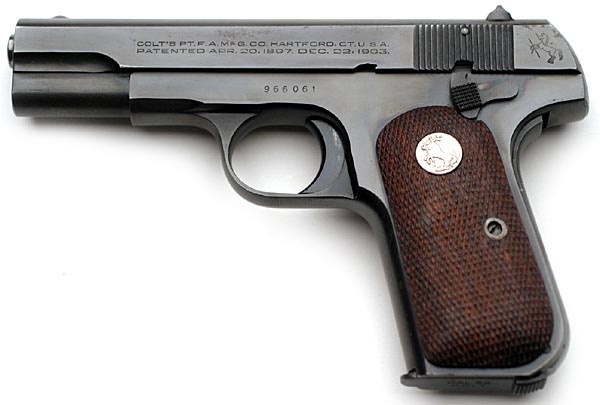 Colt Model 1903 Pocket Hammerless .32 ACP serial number
966061 - OSS / CIA issued military contract pistol outside the known and
established serial number range. The highest recorded production
number is 572215, with serial numbers 572216 through 572451 being
manufactured but never assembled, being scrapped in 1945.
Seven serial numbers numbers higher than the highest known number on this
model have been observed. 831093, 831215, 831242, 831289,
831291, 966061 and
966071. Two of the pistols
that are identified by John Brunner in his book on the Colt Pocket
Hammerless Models (831093 and 831242). Four of the seven are known to have had their
original serial numbers removed along with other government markings and
were marked with a serial number that could not be traced to the U.S.
Government. Colt Model M .32 serial number 966061 was issued
to Lt. Col. Alexander Sogolow (also spelled Sogolov), a Russian born
CIA agent stationed in Germany following WWII. Accompanying the gun is
a modified unmarked shoulder holster as well as documentation. This
pistol has all the military characteristics of a war time manufactured Model
M .32 pistol.
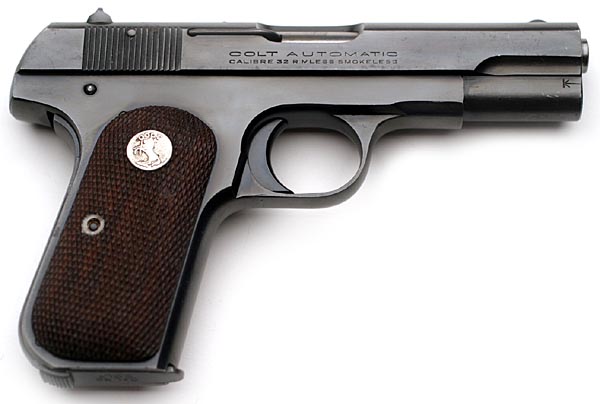 Right side of Colt 1903 Pocket Hammerless serial number
966061. Note lack of U.S. PROPERTY mark.
|
Lieutenant Colonel Alexander Sogolow |
| Born: 9 February 1912 |
Russia |
| 1947 |
Munich, Germany |
| 1968 |
U.S. Government Official
Headquarters, U.S. Army element, Joint OPS Group, R.1B 945, The Pentagon |
| Died: 19 January 1982 |
Burial: Arlington National Cemetery, Arlington,
Virginia
Plot: Sec: 59, Site: 2608 |
|
Alexander Sogolow - Obituary, January 23, 1982
Alexander Sogolow, 69, a retired Army lieutenant colonel
and senior intelligence officer with the Central Intelligence Agency,
died of respiratory failure Tuesday at the National Naval Medical
Center. He lived in Chevy Chase.
Col. Sogolow was a native of Kiev, Russia. He came to this country in
1926 and settled in New York City. He was a 1936 graduate of the City
College of New York and attended St. John's University law school in
Brooklyn.
He served with the Army in Europe during World War II. He was an
intelligence officer for the U.S. High Command in Berlin and a Russian
and German interpreter for senior allied officers, including Generals
Eisenhower and Patton. He left active duty in 1948 as a lieutenant
colonel and joined the Army Reserves, from which he retired in 1972.
Col. Sogolow joined the CIA in 1949 as an intelligence officer in
Germany. During his years with the agency, he lived in Washington and
Germany. Since 1963, he has lived in Washington and Chevy Chase. He
retired in 1972.
He was a member of the Association of Former Intelligence Officers, the
Central Intelligence Retired Association, the Retired Officers
Association and the American Association of Retired Persons. He was a
volunteer for the American Red Cross.
Survivors include his wife, Phyllis, of Chevy Chase; a daughter, Terry,
of Silver Spring; a son, Robert, of Van Nuys, Calif., and a sister,
Tamara Weinschenker of New York City.
The family suggests that expressions of sympathy be in the form of
contributions to the American Heart Fund or to the American Cancer
Society. |
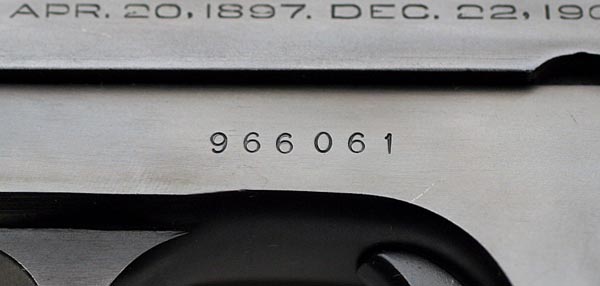 Close up of serial number 966061. Style is different
that that of serial numbers applied at Colt.
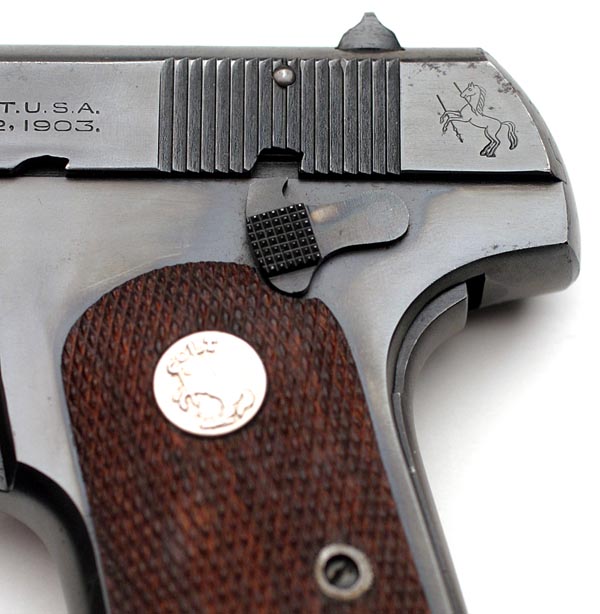 There is no ordnance mark present behind the thumb safety.
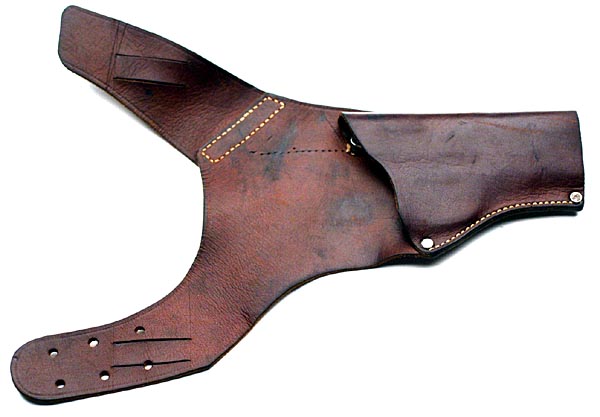 Unmarked shoulder holster that accompanied Model M .32 sn
966061 (front view)
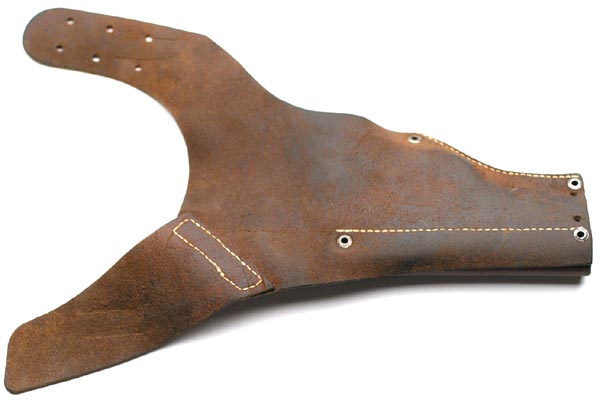 Unmarked shoulder holster that accompanied Model M .32 sn
966061 (rear view)
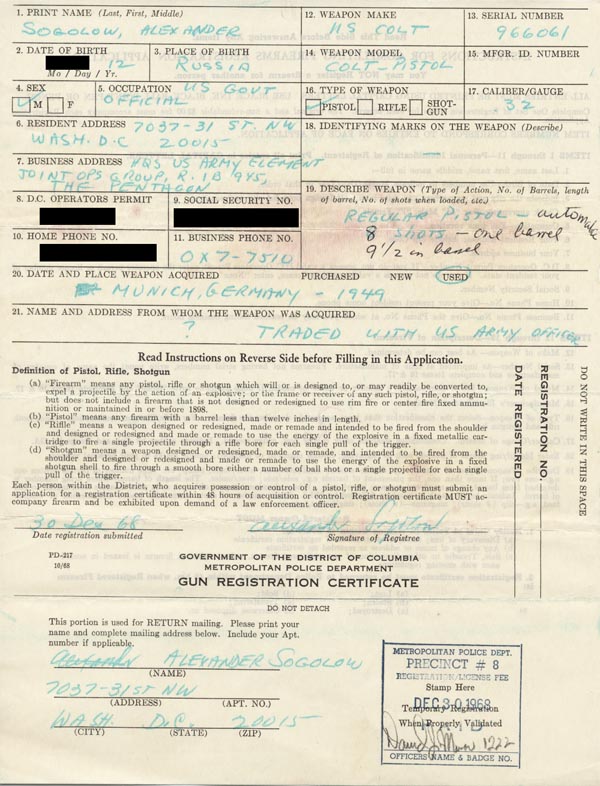 Alexander Sogolow's Gun Registration Application for
Colt
Model 1903 Pocket Hammerless .32 966061 dated December 30, 1968.
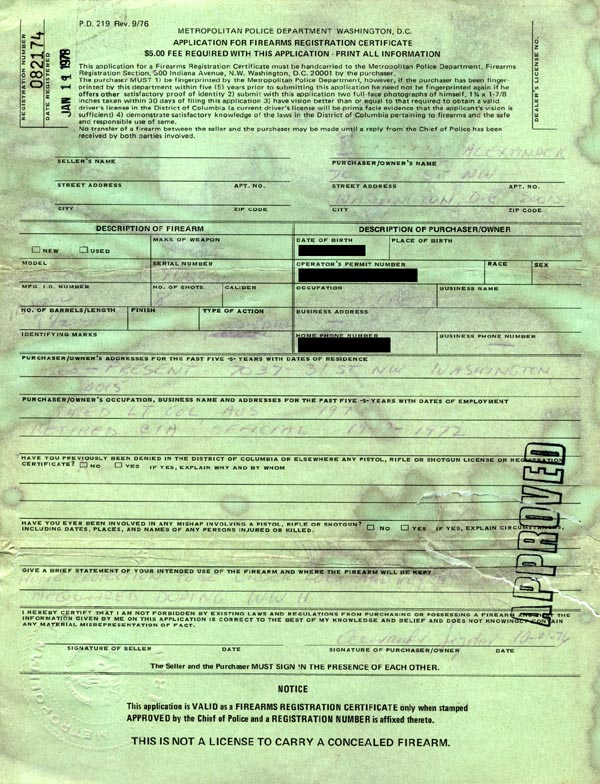 Alexander Sogolow's Gun Registration Application for
Colt Model 1903 Pocket Hammerless .32 966061 dated October 21, 1976,
but not approved until January 19, 1978.
MOLEHUNT - THE SECRET SEARCH FOR TRAITORS THAT SHATTERED THE CIA
(c) 1992 by David Wise
Excerpt from Chapter 12: Molehunt
"There were others, many others. One of those placed under the
counterintelligence microscope was Alexander Sogolow, a large and boisterous
Russian-born case officer from Kiev who had the misfortune to be known
throughout the agency by the name Sasha.
It was Sogolow whom Peter Karlow had been thinking of when the polygraph
operator asked him about "Sasha," making the needle jump and putting Karlow
deeper into the quagmire. In Russia, many names have diminutives,
affectionate nicknames that friends and family use in place of the more
formal given name. For Alexander, the diminutive is always Sasha.
Assigned to headquarters in the early 1960s after a tour in Germany, Sogolow
got wind of the fact that the mole hunters in Langley were looking for
"Sasha." On a trip to Vienna, he unburdened himself to Kovich, who was then
serving in the Vienna station.
"They're going to come after me," Sogolow bemoaned. "I'm in trouble. They
say his name is Sasha."
"Hell," Kovich assured him, "relax. There are eighteen million Sashas in the
Soviet Union." Ironically, it was the first that Kovich had heard about the
search for penetrations back at headquarters. He didn't know that he himself
was a suspect.
Sasha Sogolow was born in czarist Russia in 1912, the son of a wealthy
Jewish businessman who supplied uniforms for the Russian army. Sogolow used
to tell the story of how, when the revolution came, the family fled to
Germany, their jewels hidden in a toy cane that was given to him. The family
made it safely to Germany, but little Sasha lost the cane. At least that is
how Sogolow liked to tell the tale. [15]
The Sogolows immigrated to New York in 1926, where Sasha graduated from City
College and St. John's University Law School. It was the Depression, and
Sogolow, according to a CIA colleague, "worked for a while selling
chicken-plucking machines, until he was beaten up by a bunch of manual
chicken-pluckers." [16] During World War II, he was an Army intelligence
officer, acting as an interpreter for General Eisenhower and General Patton,
and then working for the High Command in Berlin. Rejoined the CIA in 1949
and was sent to Germany.
Since the Soviet Union was the main target of the CIA, the agency needed
Russian-speakers. Like Sogolow, many officers in the Soviet division
inevitably had Russian backgrounds, which to the mole hunters made them all
the more suspect.
And Sogolow, despite Kovich's ironic reassurances, was under suspicion by
the SIG. He had a Slavic background and had served in Berlin. It was true
that his name did not begin with the letter K, but by now, the CI Staff was
not wedded to that detail of the mole profile. The search for penetrations
had begun to spread to other letters of the alphabet.
Worst of all for Sogolow, his name was Sasha. On the face of it, it seemed
unlikely that the KGB would use the code name Sasha for someone who really
was called Sasha. But it was not impossible, and in the atmosphere of the
time, the CI Staff was leaving nothing to chance.
"We looked at his file," Miler recalled. "We went over operations he was
involved in in Germany, where he had been." The SIG, Miler said, was
particularly interested in Sogolow's "proximity" to Igor Orlov, a
Russian-born CIA contract agent who had worked for Sogolow in Frankfurt in
the late 1950s, and who was emerging as the
newest suspect.
As for Sogolow, Miler said, "nothing was found." He was not transferred to a
lesser job, Miler insisted, nor placed in the limbo that awaited other
targets of the mole hunters in the D corridor. But Sogolow was never to
reach the level he had hoped for within the agency."
[15] It made a nice story, but it seemed improbable that the jewels would
have been entrusted to a five-year-old. Within the Sogolow family, the
accepted version was that the jewels had been smuggled out of Russia in the
heel of the shoe worn by Sasha's older sister.
[16] David Chavchavadze, Crowns and Trenchcoats: A Russian Prince in the CIA
(New York: Atlantic International Publications, 1990), p. 154. |